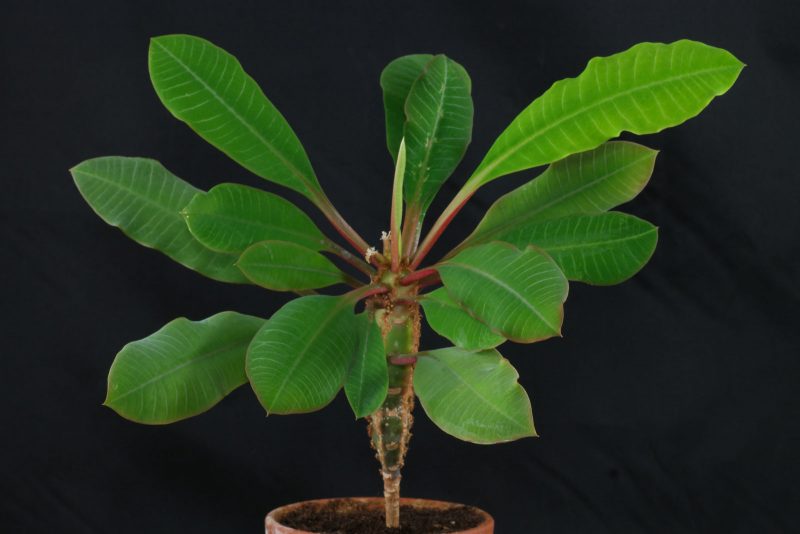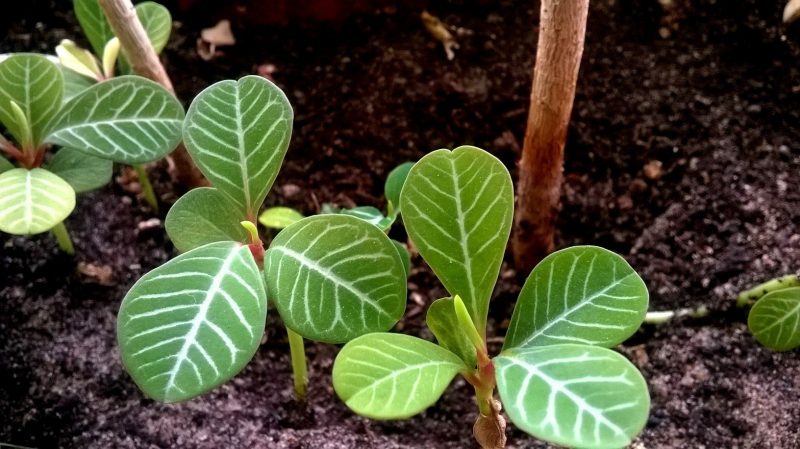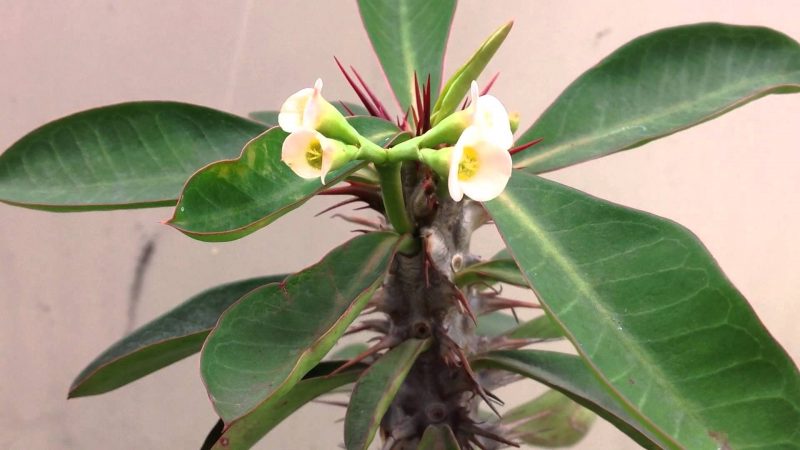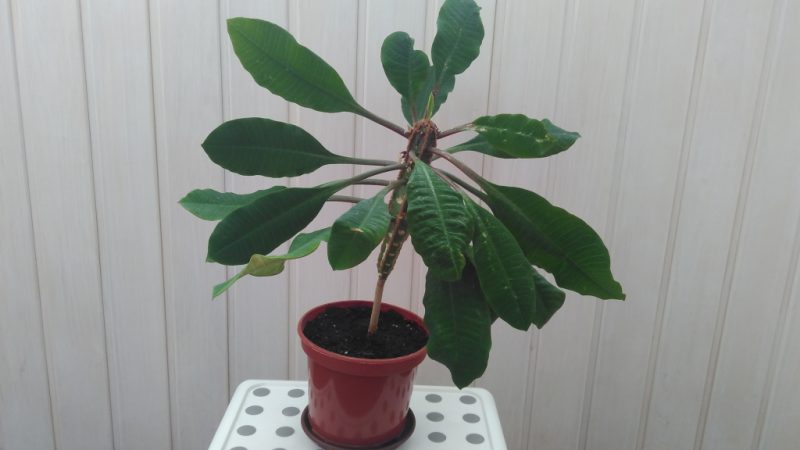Many flower growers begin replenishing their collections by planting a white-veined euphorbia. This extremely unpretentious houseplant easily forgives mistakes in care and is completely unpretentious. But it looks exotic at the same time.
Material Content:
Description, nuances of growing
People call the euphorbia a cactus, palm tree or even a banana. Looking at a flower you understand where such names come from.

A white-veined euphorbia from Madagascar. The plant has a fairly thick and at the same time dense stem, which really resembles a cactus. On the trunk there are scaly ribs, and on the top there is a bunch of decorative leaves.
- Glossy foliage of saturated green color is collected in a socket, which creates a "palm effect".
- Lush greens may have whitish or yellowish marks.
- The plant blooms with small flowers that are located directly in the axils of the leaves.
- The flowering period in milkweed in the house starts with the beginning of spring and lasts until the end of summer.
The main decorative value of milkweed is leaves, flowering does not decorate the plant in any way.
Growing euphorbia, you need to consider that it is poisonous.
Therefore, he does not have a place in the children's room. All work with the flower should be carried out with gloves and especially when cutting and transplanting it. Therefore, think about whether it is possible to keep a white-veined euphorbia at home if you have kids or pets.
Plant propagation methods
The most common way to propagate this flower is by seed.

And to grow euphorbia from seeds is quite simple:
- In the fall, seed bolls are collected from the plant, which must be stored during the winter in a warm and dark place.
- Already with the arrival of the first March days, they are preparing for sowing. First, the seeds are wiped to slightly drain off a rather thick shell.
- Then the prepared material is planted in a warm and necessarily loose soil, deepening by 5 mm. You can press seeds into the ground with a knitting needle or pen. Many flower growers simply lay them out on the soil surface in a flowerpot, and then sprinkle a thin layer of soil on top. Planted raw materials are watered with cold water.
- For the next 14 days after sowing, the container should be tightened with foil and taken to a cool place. Planting regularly ventilates and moisturizes.
- At the 3rd week, the containers are rearranged on the windowsill, where there is more light. Usually by this time shoots appear amicably.
- When the seedlings are strong enough, they pick them, planting in separate pots.
The seed method is very simple, but many flower growers do it even easier, using the sprouts that appear in the fall after self-sowing for milkweed propagation. You can simply put containers with a substrate next to the pot and when the seed boxes begin to burst, the seeds will fly apart, fall onto wet, prepared soil and sprout on their own.
With the beginning of summer, the white-veined euphorbia begins to grow actively, and, first of all, the side shoots move in growth. They can be taken for breeding.
- A sharp knife or scissors cut the best lateral shoots and, preferably, as close to the trunk as possible.
- The processes are placed in water.
- The juice will flow for approximately 20 hours. After a day, the wounds are treated with crushed coal and the cuttings are again placed in water.
- Within a week, the seedlings are buried in the sand mixed with peat. It is advisable to keep the euphorbia at a temperature of about + 24ºС. The first month such plants require painstaking care.
Ideal conditions for keeping white-veined milkweed
In the wild, milkweed form almost impassable, dense thickets. At home, this plant is unpretentious and you can easily create ideal conditions for it.

It needs bright light, therefore it is optimal to put the pot on the east window. The flower is rotated regularly around its axis to form a beautiful crown and a strong, even trunk.
The culture is very thermophilic and the best temperature for its maintenance is +23 - 24 degrees. It does not tolerate euphorbia drafts and severe cooling. Therefore, in summer it can be taken out onto the balcony, but with the first autumn cooling, the euphorbia is again brought into the house.
It is interesting:perennial garden spurge
Milkweed Care at Home
When growing, it is very important to observe the irrigation regime.

- "Palm" loves moisture very much and therefore it is necessary to water it often, but being careful not to fill it too much.
- As soon as the earthen lump in the flowerpot begins to dry out, the flower should be abundantly watered.
- In winter, carefully watered so that excess water does not provoke the onset of root rot.
- In the heat once a week, a flower is bathed in a cool shower. You can also wipe the foliage with a wet cloth so that dust does not settle on it.
- If the room is too low in humidity, it is advisable to place containers with water or spray air around the plant near the pot.
Although euphorbia is not picky about air humidity, at this rate below 50%, decorative foliage may begin to dry out.
The plant is very fond of mineral dressings, which can be bought in specialized stores. But it’s important not to overfeed the euphorbia - just one fertilizer per month is enough.
At about 2 to 3 years of age, the flower should be trimmed, since the root system may not withstand the full power of the green mass of leaves. For this, the tip is simply cut off, and the cut is treated with powder coal. The top is put into business for the propagation of a flower.
Every year, the plant is also pruned, but not all beginner growers know how to prune the white-veined euphorbia correctly, and when exactly.But here everything is simple - as soon as the plant fades, its shoots need to be shortened by about 15 cm.
Plant Transplant Features
It is a must to transplant the euphorbia. They do this once a year, and for adults only one transplant every 3 years is enough.
It is interesting:spurge

As the flower grows, the size of the pot increases. Drainage is laid at its bottom, as many gardeners use chipped red brick or small pebbles. In the first couple of months after transplanting, the flower must be carefully taken care of and try not to disturb it, since rearrangement to a new place can be fatal.
It is better to transplant euphorbia in the spring.
The soil mixture for this can be composed of:
- turf
- sand
- peat moss
If the soil will be purchased in the store, then the soil mixture for succulents will do.
The flowerpot for planting must be wide.
Pest and Disease Control
Unfortunately, the process of growing milkweed is not always complete without diseases and even pests.

- Very often, the flower is affected by gray rot, which is manifested by the formation of olive plaque. The diseased parts of the flower should be cut off, and the plant itself should be treated with the “Fundazole” solution.
- It affects euphorbia and late blight, which slows down growth and destroys the root system. The plant will have to be transplanted into clean soil, cut off the diseased parts of the roots, and spray the flower with fungicides.
- As a result of waterlogging of the soil during irrigation, spurge can affect spotting. The ground part of the flower in this case is sprayed with Vectra.
- Of the insect pests, the indoor flower is often attacked by a spider mite that sits a thin web on the shoots and feeds on leaf juice. In this case, the foliage is washed in the shower, and then sprayed with Fitoverm.
Is it possible to keep euphorbia white-veined at home

You can keep such a "palm" at home, but when leaving, it should be borne in mind that this plant is poisonous. It contains a very toxic juice, which can provoke severe allergies and burns on the skin.












